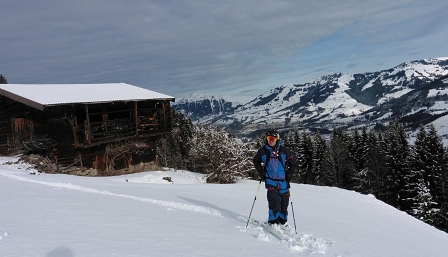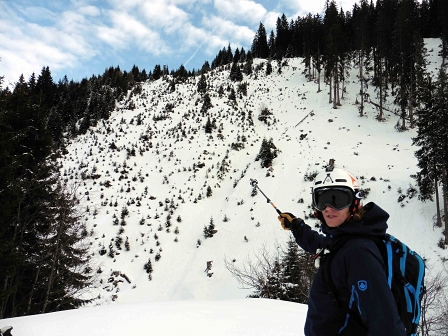Erstellt am: 3. 2. 2015 - 15:42 Uhr
Respecting Nature While Freeriding
I’m riding through a field of powder into a secluded valley in the Kitzbühel ski areas with freeride ski professionals Matthias "Hauni" Haunholder and Matthias Mayr. We've negotiated some snow-clad forests and even had to hop over a half-frozen stream.

Chris Cummins
This is what skiing is all about for me – that intoxicating mixture of adrenaline-laced adventure with the calming feeling of being in the glorious quiet of the snowy nature of the mountains. And of this shared with just a few friends.
But we are never really alone in the snowy chutes and power fields, points out Hauni, who has chosen nature protection a central theme of this year’s Kitzbühel Freeride Weeks.
The forests of Kitzbühel are home to 250 chamois as well as other wild mountain animals and these need their rest. Conservationists say off-piste skiing has had a clear impact on the mortality rate of these wild animals. As fat skis have made the joys of freeriding accessible to more and more skiers, the pressures are mounting on Austria's mountain fauna.
You might well have seen a chamois ("Gams" in German) charging off through the deep snow after being surprised by a skier or snow-shoe mountaineer. It's an impressive sight as they bound energetically through the powder. But over the course of the winter the animals pay a heavy price for this instinctive flight.
"They need absolute rest"
During the winter, explains local forester Franz Heim, the animals are in energy saving mode in this time of food scarcity in the snowy mountains. "The animals have a natural mechanism that helps them cope with the cold months. It involves the lowering of their body temperature so that they can cope with less food. But this means they need absolute rest."
Impressive as their speed is, when a chamois flees from a disturbance and shoots off through high snow and freezing temperatures, it burns off valuable calories that it can't afford to lose.
If this happens 30 or 40 times during the long winter that means the chamois will become so weak it might die. The stress of continual disturbances also contributes to the gradual weakening of the animals and Swiss conservationists say that the encroachment of skiers into the traditional resting areas has pushed chamois into in avalanche zones.

Chris Cummins
That doesn't mean that freeriders should be banished from the mountains, insists Heim. The mountains are expansive and, particularly at the relatively low altitude of the Kitzbühel Alps, have always been a meeting point on human culture and nature. There is room for both riders and animals. "The key is education," says Heim.
He says you should always inform yourself about where the animals tend to rest over winter and where winter feeding stations have been placed for the deer populations. Then, when you are already up the mountain, learn to react to potential encounters, retreating quietly when you see signs of animals and making sure you don’t make much noise.
"Inform yourself"
Matthias Haunholder says that local lift-companies will usually have the information you need at the base of the mountain. He also says a basic but essential lesson is to avoid young forests that need room to grow. There are plenty of trees to ski around without strangling the next generation.

Chris Cummins
"What we are doing is all about loving and enjoying nature," he says, "so we have to learn to respect it."


